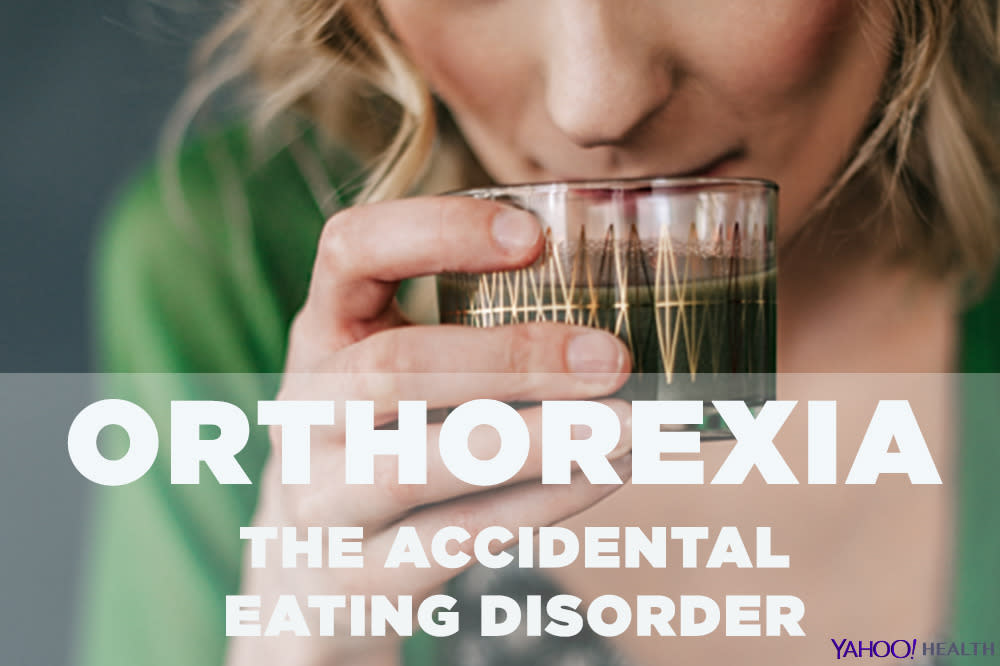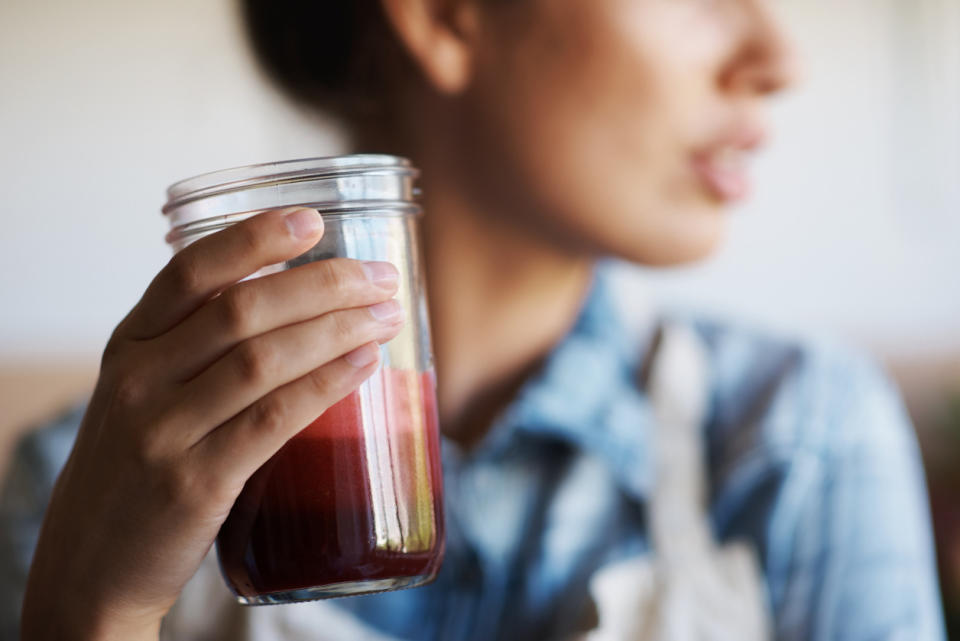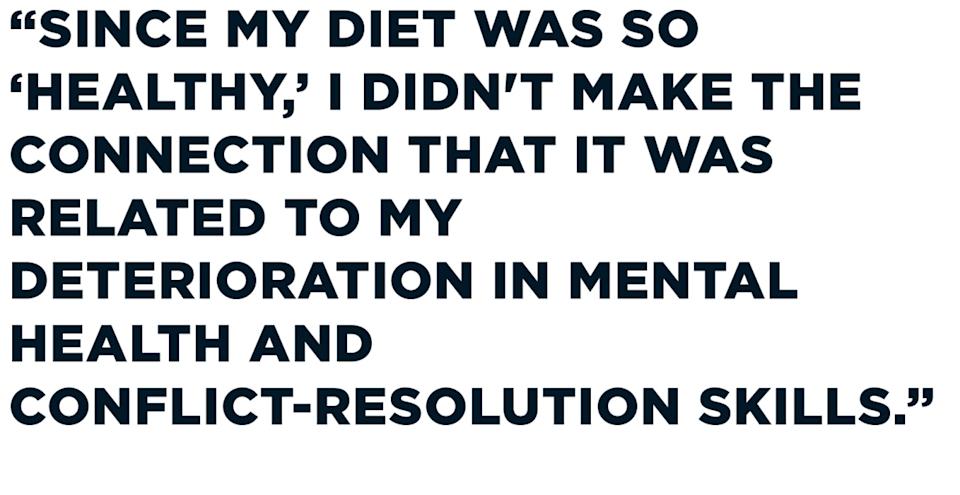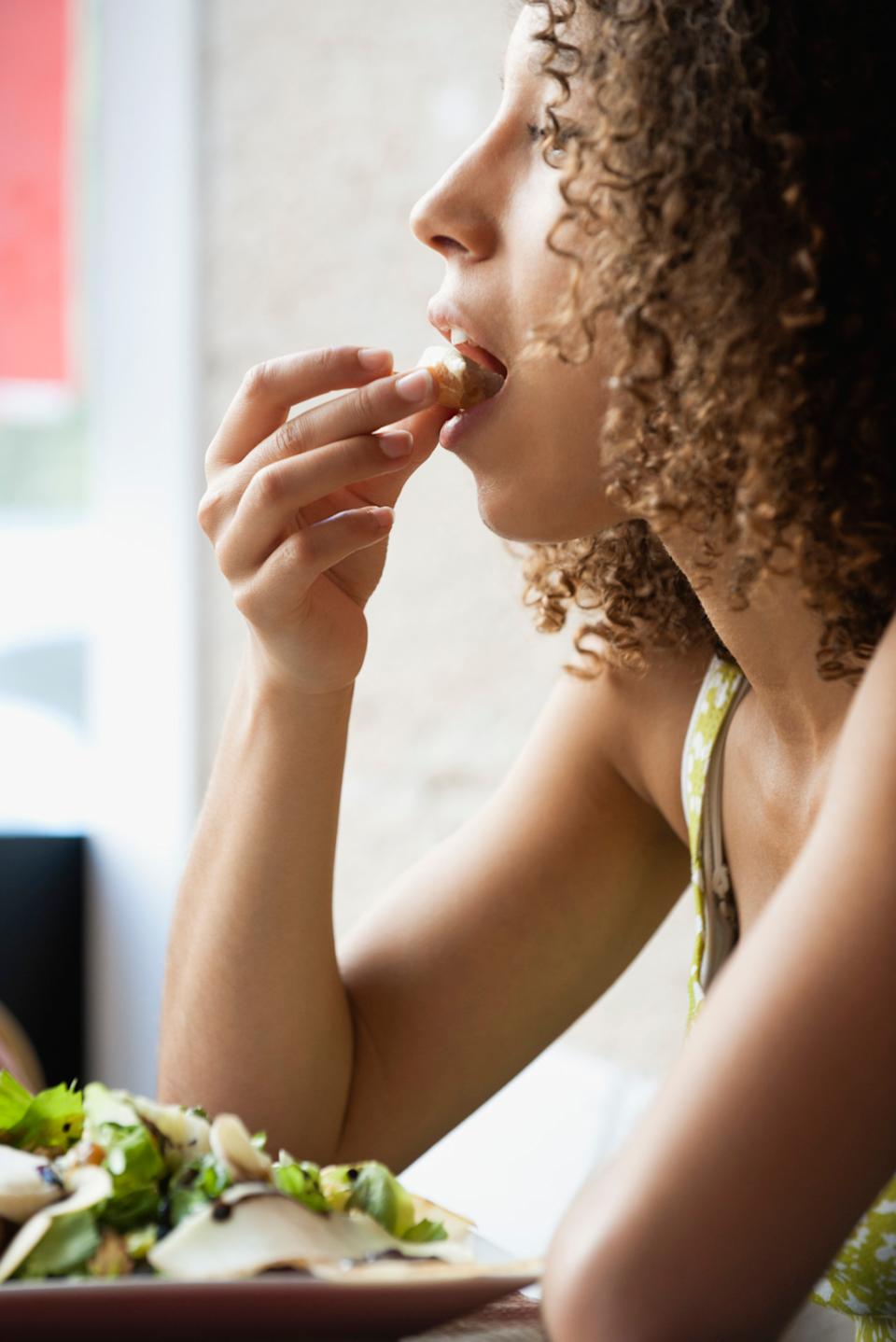The Accidental Eating Disorder That’s Powered by Social Media: Orthorexia

There’s a fine line between eating clean and eating disorder. (Image: Yahoo Health/Getty Images)
Food and I have had a tumultuous relationship.
I’ve struggled with unpredictable gastrointestinal issues my entire life, but in June 2012, at age 20, a switch flipped inside my body. I became severely ill with irritable bowel syndrome (IBS). Multiple treatment plans failed, so I decided to help myself the only way I know how: by “cleaning up” my diet. That meant whole foods only.

No more fast food. No more processed food. Way less sugar. No beverages other than water and coffee with a dot of soy.
Weight loss never crossed my mind in the beginning, but the pounds fell off over the course of a few months. Everyone noticed. I started to associate weight loss with “good.” I aimed for health and got visible, real results.
So I controlled more. I could control these variables when I could not control my body.

But over time, I developed a fear of food that did not fit my “healthy,” safe criteria. I ate less and less. My safe list shrank to six foods: iceberg lettuce, oats, egg whites, brown rice, white potatoes, and bananas. These foods didn’t stop making me sick, but they possibly made me less sick than excessive sugar and fat, I rationalized.
My thinking was far from rational, as I teetered on the brink of orthorexia nervosa, a condition characterized by an obsession with eating only healthy foods.
Orthorexia is a hot topic these days. It made headlines in the social media world last week when writer Claudia McNeilly described the eating disorder on the website Broadly.
What started as a mission to unnecessarily shed 10 pounds and reap the alleged health benefits of a Paleo lifestyle soon spiraled into an obsession with the virtues of my food. …
Soon I started making excuses about why I couldn’t go out for Chinese food or beers with my roommates.
“You’re being crazy,” my roommate would tell me. “Just get a wonton soup, you’ll be fine.” What they didn’t understand is that wontons were wrapped in the devil that was wheat, and I was looking forward to staying up late reading fear-mongering articles about the risks and benefits of different types of nut butters.

“The weight component is not there in the same way,” says Sarah Altman, PhD, a clinical psychologist at The Ohio State University Wexner Medical Center who specializes in eating disorders. “Instead, there’s an OCD component where you only allow yourself very specific foods. It’s often misdiagnosed.”
There are similarities, though. “It has the same perfectionism, the same dependency on rules and rigidity,” she says. “When you’re cutting foods, you often experience a drop in weight, and when you’re underweight, your brain becomes more rigid. There is an inflexibility to your thinking.”

Photo: Getty Images
She references a classic 1940s study by Ancel Keys called the “Minnesota Starvation Experiment,” in which researchers severely limited the diets of 36 healthy men for weeks, before assisting them with recovery. “They all developed eating disorders,” she says. “Simply as a result of losing weight, they became preoccupied with the foods they ate.”
With orthorexia, this preoccupation is the focal point, says Jessica Setnick, senior fellow at the Remuda Ranch Eating Disorder Treatment Center. “The disorder happens with someone who tends to go overboard,” she tells Yahoo Health. “If you’re the kind of person who picks up a new hobby and buys in, spends all your time and energy on it, if you’re the kind of person who plans to sit down at the computer for two hours and is still there five hours later. Eating can become that new hobby, project and obsession. And the associated weight loss just increases your obsessions and anxieties.”
I have good people in my life, who told me I was in an obsessive spiral — and luckily I saw and felt that. I started eating more, and then better, and then finally right. In time, with doctor’s help and medication, my GI symptoms also improved. And as my GI symptoms improved, so did my eating habits.

“There’s always a kernel, a traumatic experience, digestive or chewing problems, some kind of physiological issue with food,” Setnick tells Yahoo Health. “You may have to trace it back to childhood. It might be that this person got their tonsils out when they were little and couldn’t eat, or developed a fear of eating.”
For a victim of this specific type of ultraclean, ultrahealthy eating disorder, in the mind, it’s not a problem. It is a cleanse. “Somewhere down the line, their relationship with food took a wrong turn — and the change in eating was a way to solve it,” Setnick says. “It’s an attempted fix.”

No one knows how many people suffer from orthorexia and similar disordered eating habits. Research from June 2004 attempted to examine prevalence of the condition by allowing random volunteers to enroll in a study examining orthorexia-specific habits, with participants of different occupations and backgrounds. Of 404 subjects, roughly 6 percent exhibited signs.
That study was also more than a decade ago now, a snapshot in a different time, in an era with less technology and social media. “Prevalence is always a difficult question,” Altman says. “But there’s definitely more of an awareness in our field over the past four or five years, although it’s really been around since the 90s.”
The 2004 study also proves orthorexia is not exactly new — the disease was first identified by Steven Bratman, MD, in 1997. If you’ve only recently heard the term, though, there are a couple reasons for that.
First, it’s not recognized in the Diagnostic and Statistical Manual of Mental Disorders (DSM) as a mental health disorder.
And second, the rise in awareness of orthorexia can be pegged to the rise of social media and the Internet celebrities who have brought attention to the issue.

“We’re hearing about it now, because our culture is finally doing a good job of making nutrition information and nutritious food ideas available, and we’re all talking about it,” Setnick says. “It’s a status thing. You take pictures of what you’re eating or doing, it spreads. It’s not some secret ‘health nut’ behavior anymore.”

Jordan Younger, the Balanced Blonde. (Photo: Instagram)
Jordan Younger is a prime example of society’s effect on hyperhealthy eaters; culture does not cause disordered eating, but it may reinforce is. Known to many as the Blonde Vegan for years, Younger admitted in 2014 that she suffered from orthorexia. She’s currently written a memoir called Breaking Vegan, in which she describes how her clean-eating obsession nearly killed her.
A cousin of anorexia nervosa, it is rooted in the same OCD tendencies, the same need for control and restriction. The term itself comes from the Greek word “orthos,” meaning straight or proper, and “orexia,” meaning appetite. The idea behind it is quite simple: place extreme limits on food selection, with an obsession centered on eating only healthy and “clean.”
Younger had lifelong GI issues. After going through a rough breakup when she was in college at Loyola Marymount in 2012, she began to lose weight. “I lost my appetite, I lost weight — I had tried everything and it was my way of telling the world I was upset,” she tells Yahoo Health.

Jordan Younger. (Photo: Instagram)
This combination of jarring life change and lifelong health problem was a trigger, where she began channeling her energy into dietary changes. She embarked upon a five-day, plant-based cleanse in January 2013 that included two juices, one smoothie and veggie meals to supplement daily. “Afterward, I felt really good,” she says. “I thought, ‘This is the answer.’”
The answer, she thought, was veganism. “I thought, ‘I feel good, I’m doing something good for the animals and environment,’” she says. “But I took the rigidness to an extreme. I lost my energy. I was freezing all the time. I had no color. I lost 20 pounds. It was visible to everyone.”
At the same time, she was also beginning to pick up steam as The Blonde Vegan, posting healthy recipes and lifestyle pics on instagram. She was heavily involved in exercise and yoga in addition to her new diet. “And then, I started my blog. I was this vegan girl, sharing all her vegan tips — it pushed me into this ‘vegan extreme’ lifestyle,” she says. “I became addicted to cleansing, and then I got wrapped up on raw veganism.”
Younger’s diet consisted of only “healthy” vegan foods. Berries, green juices, a little quinoa sometimes, carrots and sweet potatoes. “My skin actually started to turn orange from these foods that I was eating,” she says.

A 2012 study published in the Journal of the Academy of Nutrition and Dietetics looked at the relationship between vegetarianism and eating disorders; those with a history of eating disorders were far more likely to have ever been a vegetarian compared to a control group (a whopping 52 percent vs. 12 percent), and more than two-thirds of the subjects in the study said that they perceived that the two issues were connected.
In April 2014, Younger came home from school to see her friends and family for the first time in months. “They were alarmed,” she says. “They said I didn’t look healthy. I was always hungry, and nothing was satisfying. They encouraged me to eat fish, eggs — something substantial to fuel my body. Everyone was walking on eggshells around me.”
Instead of heeding this advice, Younger embarked on a 30-day juice cleanse. “And that was the final straw,” she says.
She visited a friend in New York, who had suffered from an eating disorder. “I talked to her about it,” she says. “The comparisons were so noticeable.” At that moment, Younger admitted she had a problem, and began to seek help. In June 2014, she renamed her blog “the Balanced Blonde.”

According to a 2014 study from Hungary published in BMC Psychiatry, the researchers found orthorexia was not just associated with obsessive healthy- food choices, but with shopping at health-food stores and would-be healthy lifestyle habits (like less alcohol and more physical activity).
Wendy Greene was 21 when she started bodybuilding as a hobby. To prepare for competitions, she would often engage in 12 weeks of intensive exercise and strict dieting. “I’m extremely competitive, and a perfectionist, so aligning that with body image and getting into a sport that is based on aesthetics created a perfect storm,” she tells Yahoo Health. “Like an alcoholic becoming a bartender.”
That perfect storm swirled slowly downward. “I always knew extreme dieting couldn’t be sustained longer than it takes to prepare for fitness or bodybuilding competitions, but I certainly wanted to believe it was possible to stay healthy, and be just a couple weeks out from photo-shoot or competition shape at all times,” she explains. “After all, I had seen other people do it — or at least the image they were portraying on social networking was that this is what they were doing.”
Greene began to buy into that sustained image of perfection, and eat accordingly. “I was eating whole, natural, nonprocessed foods in an effort to lower my body fat,” she says.

“I thought something else was wrong, and went to several therapists and psychiatrists that would prescribe medications that only made my mental state worse,” says Greene.
On some level, Chuck F. didn’t realize his would-be healthy habits were problematic either. He first developed an eating disorder at age 16, as he was trying to get into better shape for basketball season.
Related: Risky Workout Supplement Use Could Be Sign of an Emerging Eating Disorder
He was officially diagnosed at age 18 with anorexia nervosa, but looks back now and sees many orthorexic tendencies. “I was very fat-phobic,” he tells Yahoo Health. “Everything I ate was very low-fat. As I got older, all of this continued and I tried to get by on as little food as I could.”

Photo: Getty Images
Also, the treatment he originally got didn’t stick. Chuck went back at his over-the-top health regimen, extending well into his 20s. His eating habits were rigid and fear-induced. He’d go many hours between meals, choose only specific low-calorie foods and make it look to others like he was eating when he wasn’t. On top of that, he was excessively exercising.
“I let my exercise determine how I felt about myself and how much I could eat on a certain day,” Chuck says. “I suppose I always knew this wasn’t healthy — but the impact on my health was what really started to let me know that something was going on.”

“I know that things could have gotten very serious, very quickly, if I had continued down this road,” he says. “And from a cognitive standpoint, when your brain is so focused on food and what your next exercise is going to be, it makes it very hard to focus on people or anything else around you.”
When Chuck was about 25, his friends and family told him his behaviors were difficult to watch — and impacting their lives, as well. At this time, he sought help a second time at the Eating Recovery Center.
Related: For Young Men, Eating Disorders Aren’t Always So Obvious
Heather Waxman also suffered through disordered eating of her own, and co-authored a book with Kasey Arena called Body Peace: Release Shame and Discover Body Freedom.
Waxman’s mother was herself an insanely picky eater, and as a child, Waxman obsessed about food. “I didn’t have an ED, but I thought about food all the time,” she tells Yahoo Health.

This was a catalyst. “I wasn’t extreme at first, but I was a believer,” she says. Slowly, Waxman thought maybe she should eliminate candy and eat a little healthier. But in the midst of the chaos of her parents’ struggling marriage, she channeled her energy into controlling variables she could manage. Eventually, she was down to 900 to 1,200 calories a day. She was eating lots of Special K cereal, and she was working out on very specific machines at the gym for very specific times.
“I am 5’8”,” she says. “I was down to 109 pounds. My hair was thinning, and I lost my period for years.”
Finally, something snapped — the right way. “One night having this extreme impulse to eat popcorn,” she says. “And I remember this urge, where I actually said, ‘No,’ out loud. I went down in my basement and I sobbed for hours.

“You need to take a deeper look and figure out what is going on underneath, says Chuck. “Eating disorders are usually about something deeper manifesting itself. For me, my eating disorder was a way to cope with discomfort and loneliness. I moved around a lot and it was hard for me to make friends. If I had to get my workout in or I wanted to avoid a social event, I could fall back on my eating disorder and say that I had to exercise or I had to make my own meal.
“The eating disorder is not going to solve your problems,” he says.
We live in a culture at once very conscious of health and suffering from a lack of it, vacillating between green juices and Type 2 diabetes, the obesity epidemic and fitness trackers. Obesity gets more of the publicity as a global health epidemic, but many still suffer from eating disorders that focus on thinness and “health.”
We live in a world that perpetuates ideals of thinness and healthfulness, and blurs the lines between them. Often, we strive for healthy, and if getting thin is a natural byproduct, so be it.

“It’s social. It’s lauded. And the difference is in the spoken purpose. You can say, ‘I want to be healthy,’ and not ‘I want to be thin.’” But you’re still aiming at both.
Awareness of orthorexia and the modern methods that reinforce it, and mindfulness of your own health habits and personality, are all important aspects of prevention. “If you have the thought, ‘I can’t eat that, I’ll get cancer,’ or ‘I can’t eat that, I’ll get fat,’ don’t counteract yourself with facts,” says Setnick. “Don’t think, ‘No, I will not get fat.’ You can’t beat your irrational thoughts with logic. I heard a saying long ago, which I now understand in relation to our thoughts: Don’t believe everything you think.”
Watch what you dwell on too, says Ovidio Bermudez, MD, chief clinical officer of the Eating Recovery Center. “Healthy eating can devolve into an eating disorder when it crosses into the realm of obsessions and compulsions,” he tells Yahoo Health. “Even drinking water, which is not just good for you, but also necessary, can become so compulsive that can lead to serious complications and even death. Healthy eating can enhance our health and well-being, or it can be a banner under which we are robbed of that.”
Setnick says you have to be aware of your personal triggers, innocuous as they may seem. “You may be able to take the cooking classes and not dwell on every dish and ingredient, but if it becomes an obsession with the food, maybe you can’t.”
Altman says the same thing goes for foodie tech habits.

“There’s so much information out there, and a lot of it is opinion, and a lot of it is extreme. Social media spreads it, and there’s an idea of what’s categorically healthy and unhealthy. Someone will cut all fat, cut white sugar without a lot of knowledge about why they’re doing it. A kind of balanced thinking needs to be brought back.”
We need to forgive our so-called dietary sins, not reducing our self-worth that day to eating “clean” or “unclean” foods. One fatty food will not destroy you.
Beating yourself up about each and every dietary choice is a slippery slope to disordered eating. “We know health and nutrition is about weeks, months, and years, not one single decision or meal,” says Setnick. “And ultimately, you cannot control everything. There is no magic diet to extend your life; the reality is, you cannot control when you die. No one gets out of this life alive.”
Read This Next: How One Girl Is Recovering From an Eating Disorder — And Helping Others Find Hope
Let’s keep in touch! Follow Yahoo Health on Facebook, Twitter,Instagram, and Pinterest. Have a personal health story to share? We want to hear it. Tell us at YHTrueStories@yahoo.com.

